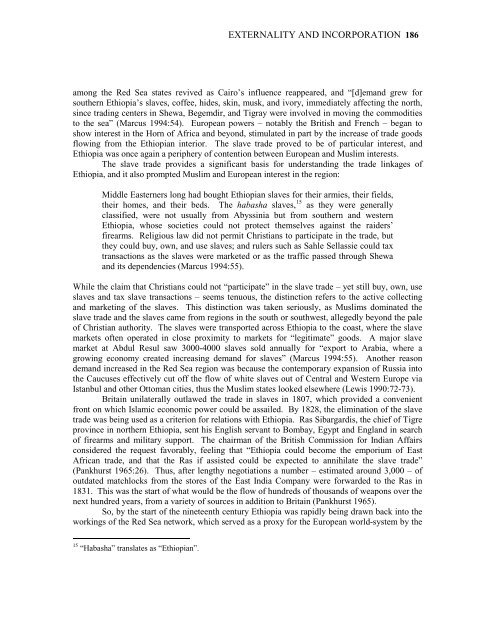Entire Volume 17 issue 1 - Journal of World-Systems Research ...
Entire Volume 17 issue 1 - Journal of World-Systems Research ...
Entire Volume 17 issue 1 - Journal of World-Systems Research ...
You also want an ePaper? Increase the reach of your titles
YUMPU automatically turns print PDFs into web optimized ePapers that Google loves.
EXTERNALITY AND INCORPORATION 186<br />
among the Red Sea states revived as Cairo’s influence reappeared, and “[d]emand grew for<br />
southern Ethiopia’s slaves, c<strong>of</strong>fee, hides, skin, musk, and ivory, immediately affecting the north,<br />
since trading centers in Shewa, Begemdir, and Tigray were involved in moving the commodities<br />
to the sea” (Marcus 1994:54). European powers – notably the British and French – began to<br />
show interest in the Horn <strong>of</strong> Africa and beyond, stimulated in part by the increase <strong>of</strong> trade goods<br />
flowing from the Ethiopian interior. The slave trade proved to be <strong>of</strong> particular interest, and<br />
Ethiopia was once again a periphery <strong>of</strong> contention between European and Muslim interests.<br />
The slave trade provides a significant basis for understanding the trade linkages <strong>of</strong><br />
Ethiopia, and it also prompted Muslim and European interest in the region:<br />
Middle Easterners long had bought Ethiopian slaves for their armies, their fields,<br />
their homes, and their beds. The habasha slaves, 15<br />
as they were generally<br />
classified, were not usually from Abyssinia but from southern and western<br />
Ethiopia, whose societies could not protect themselves against the raiders’<br />
firearms. Religious law did not permit Christians to participate in the trade, but<br />
they could buy, own, and use slaves; and rulers such as Sahle Sellassie could tax<br />
transactions as the slaves were marketed or as the traffic passed through Shewa<br />
and its dependencies (Marcus 1994:55).<br />
While the claim that Christians could not “participate” in the slave trade – yet still buy, own, use<br />
slaves and tax slave transactions – seems tenuous, the distinction refers to the active collecting<br />
and marketing <strong>of</strong> the slaves. This distinction was taken seriously, as Muslims dominated the<br />
slave trade and the slaves came from regions in the south or southwest, allegedly beyond the pale<br />
<strong>of</strong> Christian authority. The slaves were transported across Ethiopia to the coast, where the slave<br />
markets <strong>of</strong>ten operated in close proximity to markets for “legitimate” goods. A major slave<br />
market at Abdul Resul saw 3000-4000 slaves sold annually for “export to Arabia, where a<br />
growing economy created increasing demand for slaves” (Marcus 1994:55). Another reason<br />
demand increased in the Red Sea region was because the contemporary expansion <strong>of</strong> Russia into<br />
the Caucuses effectively cut <strong>of</strong>f the flow <strong>of</strong> white slaves out <strong>of</strong> Central and Western Europe via<br />
Istanbul and other Ottoman cities, thus the Muslim states looked elsewhere (Lewis 1990:72-73).<br />
Britain unilaterally outlawed the trade in slaves in 1807, which provided a convenient<br />
front on which Islamic economic power could be assailed. By 1828, the elimination <strong>of</strong> the slave<br />
trade was being used as a criterion for relations with Ethiopia. Ras Sibargardis, the chief <strong>of</strong> Tigre<br />
province in northern Ethiopia, sent his English servant to Bombay, Egypt and England in search<br />
<strong>of</strong> firearms and military support. The chairman <strong>of</strong> the British Commission for Indian Affairs<br />
considered the request favorably, feeling that “Ethiopia could become the emporium <strong>of</strong> East<br />
African trade, and that the Ras if assisted could be expected to annihilate the slave trade”<br />
(Pankhurst 1965:26). Thus, after lengthy negotiations a number – estimated around 3,000 – <strong>of</strong><br />
outdated matchlocks from the stores <strong>of</strong> the East India Company were forwarded to the Ras in<br />
1831. This was the start <strong>of</strong> what would be the flow <strong>of</strong> hundreds <strong>of</strong> thousands <strong>of</strong> weapons over the<br />
next hundred years, from a variety <strong>of</strong> sources in addition to Britain (Pankhurst 1965).<br />
So, by the start <strong>of</strong> the nineteenth century Ethiopia was rapidly being drawn back into the<br />
workings <strong>of</strong> the Red Sea network, which served as a proxy for the European world-system by the<br />
15 “Habasha” translates as “Ethiopian”.





